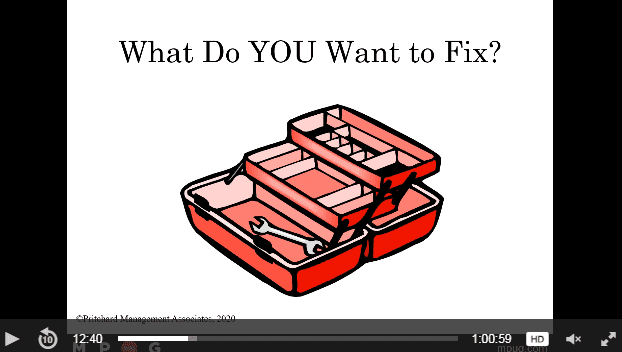As a project manager, you’ve likely already been in a position to demonstrate a new project to stakeholders. How good are your presentation skills? Here’s a collection of poor tactics, bad errors, and faulty steps you can take to increase the likelihood that your demo will be a failure or — worse — a stunningly awful demo (SAD). We recommend that you avoid doing these things! If your organization’s demos are not as successful as you might wish, consider using this list as an assessment tool. If these items are occurring in your real-life demos then you may want to contemplate making some changes.
1. Be Unclear on the Stakeholders’ Needs: “The Harbor Cruise”
Offer and deliver a demo in the hope that your stakeholders will see something of interest, eventually. This is a case of using Hope as a Strategy…! Customers refer to these long, tortured demos as:
- “Show up and throw up.”
- “Say and spray.”
- “Oh, gawd, it’s the Harbor Cruise Demo…” (they climb aboard the boat, get driven around the harbor for three hours while being asked, “Have you seen anything you like so far” — and they can’t get off the boat until the end of the ride…!).
- “The Torture Tour.”
Inexperienced presenters often inflict these demos on other participants as a replacement for not taking the time to understand their audience. Jaded presenters offer these demos when they receive little or no pre-demo information from their manager or the person asking for the demo.
2. Present a Linear Demo from Beginning to End: “Where is this going…?”
Have you ever been watching someone else’s demo and, 15 minutes into the process, started wondering, “Where is this going?”
You can ensure the same awful fate for your customers by delivering long, linear demos that start at the beginning of a workflow and take 40 or 60 minutes (or longer!) to finally reach the big pay-off screen. Follow this tactic to ensure that:
- Your audience is half-asleep by the time you reach the important take-away message and key pay-off screen. (In some geographies your audience may actually be asleep by this point…)
- The most important people in the audience leave the room while you’re still introducing the module names and key navigation features…
- The customer is so numbed by the time that you do reach your big message they can’t retain it or remember it after the demo is over.
3. Start with a Project Team Overview: “Death by Corporate Overview…”
Make Number 2, above, even worse by starting the meeting with 20 minutes of your corporate or team overview. Regale your audience with your project’s mission statement (yawn), your project team’s formation and history (yawn), including team members and roles, chronology of activities up to date, and other details that fill up slides but don’t move the understanding of your project any further (yawn, yawn, yawn, snooze…).
This strategy will ensure that, 1) the most important people leave even before you can start the demo, and 2) everyone is already bored and losing attention when you do deliver your demo. Doing this also sets you up nicely for item Number 4…
4. Don’t Reconfirm the Time Constraints for the Meeting: “Sorry, We’re Out of Time…”
You’d planned on two hours with the stakeholders when you set up the meeting three weeks ago. Is there any reason this might have changed? You arrive at 10 a.m. and right away move ahead with your agenda. Your team delivers your project overview presentation followed (after 20 minutes) by a long, linear demo…
Things are going as planned when suddenly your host looks at his watch and says, “Um, can you please wrap things up in the next five minutes? We have an all-hands meeting scheduled at 11…” You have to end the demo without ever reaching your big pay-off screen and have to ask to schedule another meeting.
5. Show as Many Features as Possible: “…And another thing you can do is…”
Want to make your software appear as confusing and complex as possible? Want to find more ways to bore and torture your audience? Want to help your stakeholders grow disinterested in the project? It’s easy: Show as many features and capabilities as you possibly can! A simple way to achieve these negative results is to present your demo as if you are doing product training — “Let me show you how to do this, and that, and this other thing…” To really inflict pain, make sure to show and explain all of the menu options, tabs, navigation tools and, of course, all of the file types you can handle. These simple steps will make your demo truly SAD.
6. Show the Same Demo, Regardless of the Stakeholder’s Role: “One for all…”
Ignore the fact that the VP in the room only wants a top-level overview of your offering and that the business managers in the room are interested only in their portion of the process.
Instead, choose the lowest-level users’ scenario for your demo. This will ensure that the senior members of the viewing team grow bored and leave the demo early (about 15 minutes after the meeting began). They’ll never see anything that compels their interest, requiring either a second demo meeting (unlikely), or a kill decision on your project.
Similarly, the business unit managers won’t be thrilled with what they see — your software will look too long, too detailed, and too complex for them to use comfortably. In the end, you’ll have done a fair job training the target end-users, but the training won’t be necessary since you won’t have to finish the project!
7. Let Questions Interrupt and Take Control of Your Demo: “But what about…?”
You’ve started your demo and things are going well when, after five minutes, someone asks a good question. You stop your demo, take a few minutes to answer the question and turn back to your laptop. Somebody else in the room asks a follow-up question, which you dutifully address in more detail, taking another few minutes.
In the meantime, what has happened to the rest of the audience? They’ve checked-out. They’re having side-conversations, checking email on their Blackberries, or are leaving the room — and you’ve barely gotten started!
Letting questions divert your demo is an excellent way to ensure that you lose the key players early in the meeting and run out of time before you’ve gotten to your key points.
Another terrific strategy for failure is to allow the Hostiles to take control of the meeting — these are the people who don’t like you, don’t like your project, or simply believe it’s their purpose in life to torture people who are trying to bring change to the organization. Let them take control and you’ll enjoy the same negative results… They’ll consume the time, bore the balance of the audience, and you’ll never get to deliver your message they way you’d desired.
8. Let Bugs and Crashes Consume You: “Gee, it’s never done that before…”
Here are three wonderful ways for you to show your software in the worst possible light:
- First, call attention to cosmetic bugs (poor screen repainting, cursor not changing, “graphics garbage,” etc.). Make sure to point out, “See that? That shouldn’t be there…!”
- Second, when you do run into a bug, say “Gosh, I’ve never seen that before.” Then try the same operation again to ensure that you run into the same bug twice! The wonderfully SAD result will be your audience thinking, “This software doesn’t really work and their best technical people don’t even know it!” Very convincing.
- Third, if your machine crashes, leave the projector attached and displaying your screen so that the audience can watch as you struggle, reboot your machine, and re-try your demo while you’re working to understand what happened. That way you can give the audience the opportunity to leave the meeting, start side conversations, and generally maximize your embarrassment.
As an added SAD bonus, when a crash or very serious bug has occurred that requires restarting your software or rebooting, make sure that the balance of your team is sitting in the rear of the room doing email on their Blackberries — or better, out in the hall making calls. This ensures there is no way they can help manage the audience while the demo machine recovers.
9. Limit the Time You Show Your Big Pay-Off Screen: “Ta-da… Any questions?”
You’ve been demoing along for 20 or 40 minutes and you finally get to your big pay-off screen — the key message. You present it for 500 milliseconds and then move swiftly to a PowerPoint slide that says, “Thank you for your time! Questions” This is a SADly terrific way to ensure that your audience never remembers your key message. While you may have seen that pay-off screen hundreds of times, this is the first time your audience has ever seen it. Showing that screen for a fraction of a second puts your message in the long list with all the other 3,000 meaningful messages your stakeholders will see that same day. Good luck!
10. Avoid Summarizing: “And the next thing is…”
Roll along from section to section, through segment after segment, in a continuous verbal assault. Leave no pauses, offer no introductions and, by all means, don’t summarize after you complete an important segment.
This SAD tactic contributes wonderfully to grow confusion, add complexity, and generally bore the tears out of your audience. For maximum SAD effect, use this tactic in conjunction with long, linear, noncomponentized, multiple-player, multi-product, multi-hour demos. You’ll have your audience examining their watches or the insides of their eyelids in no time!
Following these “Top 10” SAD guidelines will certainly increase the probability that your demos won’t help you achieve your goals. When you do these 10 simple things, you should expect your audience to say, “Yecch… That was a stunningly awful demo!”
Want to find out how to make your demos better? Read “The Great Demo! Top 10 List,” also by Peter Cohan.
Reprinted with permission from The Second Derivative.







